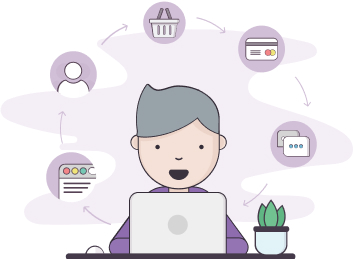We often relate prototyping to the design thinking process, assuming that's something you do when creating wireframes and mockups of future products and services.
However, design thinking is non-linear. Designers and researchers can prototype and test ideas at any stage of the development process, from conceptualization to handoff, with the help of journey mapping tools. User journey maps help understand the actions people take when using your digital product, what challenges they meet, areas for experience improvement, and more.
Prototypes based on user journey maps help test concepts and validate ideas, as well as understand users' goals and expectations related to the product or service. When validating ideas, you can start with low-fidelity prototypes using paper or digital wireframes, then connect mockups to build high-fidelity prototypes that look and function like the final product that meets the target audience’s needs.
Contents
What makes a prototype successful?

Six important things to create a successful UX prototype:
- Visual storytelling. The prototype has to tell a visual story showing how the user solves their problem.
- Knowing users’ goals and expectations at different stages of their journey.
- Coherence. Designers have to keep in mind the UX strategy and the brand experience when creating a prototype.
- Research and actual data. Otherwise, the target audience might ignore or not understand the final product.
- Interactive features. Those will help stakeholders and the product team understand how users will experience the design. To achieve interactivity, use prototyping tools that allow you to build designs with states, variables, and interactions or use interactive code components.
- UX team’s collaboration with colleagues from other departments. Brainstorming ideas with teammates outside the UX domain will allow designers to get diverse insights and perspectives. Collaboration can also help them understand production nuances and technical constraints that could affect the project.
User journey maps' role in prototyping
When it comes to prototyping, user journey maps can be a real boon. So, what is beneficial in using user journey maps in design thinking?
A user journey map visualizes how a persona interacts with a digital product, including their goals, expectations, devices, emotions, problems, and other information essential for the user's experience. Knowing your users’ tasks, barriers and pain points, actions they take, and their current experience with you, if there are any, you better understand what functionality to introduce (and include in your prototype). User journey maps give you context.
Each step of the user journey provides designers with ideas of what kind of digital product their audience wants to see, how to optimize it, and what features to highlight. Sometimes, this information confirms the hypothesis; other times, it becomes the reason for screen redesign. But it definitely brings the prototype closer to the final version.

There are more advantages of leveraging user journey maps:
- Development of products and services through empathy and understanding of the user's experience.
- Analyzing different use cases and experiences those provide.
- Uncovering new insights for further improvement.
- Providing a high-level overview of a user journey and making it easier to grasp at a glance.
- Guiding design decisions. For example, while prototyping, you may discover that some features that were not initially planned are needed to be introduced. For example, a guest checkout, as it turned out users leave the checkout page and never get back to it as they are asked to create an account.
- Eliminating assumptions. Journey maps also help designers remove any assumptions about users or their needs. Inaccurate assumptions lead to poor design decisions. For example, you assume all of your users prefer iPhones, so you develop only the iOS version of your digital product, alienating potential audiences that use Android-based smartphones.
- Pre-empting problems. When designers understand users' pain points, they see what features to introduce at every stage of a journey. For example, some grocery ordering apps allow customers to book their delivery slots before ordering. This way, they can see if a suitable time slot is available before shopping, saving the customer time and preventing frustration.
As designers start prototyping, they can identify the features customers need at every user journey stage. They can also consider how users will complete the same task based on their circumstances and environment.
Read also: Using design thinking in e-commerce
5 tips to improve your prototyping using journey maps

- We compiled a list of inspiring ideas on how to make the most out of prototyping with the help of journey maps:
- Use journey maps to identify barriers users encounter when trying to achieve their goals via your digital products and services.
- Maintain a human-centered approach. Journey maps remind designers they're solving real people’s problems.
- Revisit user journey maps throughout the design process to ensure that your prototypes and testing align with the users and their current needs.
- Create user personas to prototype not only products but people who use those, as well as to conduct deeper research and segment your audience.
- Try prototyping backwards. Start with your end goal and work your way back to when someone would open the product. Backward prototyping gives designers a unique perspective to reduce unnecessary steps or minimize the risk of forgetting key features.
Conclusion
User journey mapping is a methodology that can help you take prototyping to the next level. It allows designers to empathize with users and better understand their needs. Journey maps also help eliminate bias and assumptions designers have about the users. These assumptions often lead to poor designs, introducing usability issues and costly features people don't need.
Most importantly, user journey maps allow designers to visualize their customers as real people with human problems. Thus creating products and services that will definitely resonate with the audience and won’t be forgotten in the digital space.


